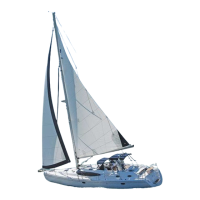nt
r
• Boatin
Safet
4.1
are
ood a capsized boat will sta
a
loat. For this reason,
sta
with the boat. Do not leave the boat or tr
to swim
to s
ore exce
t un
er extreme con
t
ons.
ca
s
ze
boat is easier to see than a swimmer, and shore ma
be
urther awa
than it appears.
.3.8 Fallin
Overboard
ne o
the most
ri
htenin
emer
encies that can occur
aboard a boat is a crew member or
ourself fallin
over-
board. Althou
h
man overboard” or
M
B” drills have
been a part o
boatin
sa
et
or decades, the
have been
ar
e
over
oo
e
man
respons
e
oat owners.
ust as important as acquirin
the knowled
e to rescue a
person is the abilit
to help
ourself if
ou are the person
verboard. Be sure and re
er to
our
hapman Pilotin
”,
eamanship and Boat Handlin
” manual supplied with
our new boat. It is packed with useful and essential
sa
et
and emer
enc
procedures to ensure
ou have a
sa
e and happ
boatin
experience.
We have the utmost interest in
our sa
et
. There
ore, we
have provided a means o
re-boardin
the boat should
ou or a crew member fall overboard.
n the transom,
we have added steps to aid
ou in re-boardin
. I
our
boat is equipped with a swim plat
orm, there is a ladder
attached to the platform which extends into the water.
.3.9 H
pothermi
I
a person
alls overboard, h
pothermia ma
be an
immediate concern. H
pothermia means a person’s bod
loses heat to the water faster than the bod
can replace
it. I
not rescued, the person will become exhausted and
likel
drown. In
eneral, the colder the water, the shorter
th
tim
f
r
rviv
l. PFD
will in
r
rviv
l tim
because the
provide insulation.
t
r
em
eratur
xh
ti
n
r
n
n-
i
n
xpected Time o
urvival
2.
nder 1
mi
nder 1
to 4
mi
2.
– 4
1
–
mi
–
mi
4
–
–
mi
–
hr
–
–
hr
– 4 hr
– 7
–
hr
– 4 hr
7
–
–
hr
hr
– in
init
v
r
In
init
In
init
.4 Fir
DA NG ER
! !
A fire aboard
our boat is serious. Explosion is pos-
sible. Respond immediatel
. Develop a fire response
an
.4.1 Fir
ver
boater should develop a
ire response plan to
determine what kind o
ire
uel, electrical, etc.
mi
ht
rea
out, w
ere
t m
t
rea
out, an
t
e
est wa
to
react. Havin
a plan and, is possible, assi
nin
responsi-
bilities to others results in quicker decisions and quicker
r
t
n
.
Important: Everyone on board should know where a fire extin-
guisher is and how to operate it.
An
ire requires stoppin
the en
ines immediatel
.
I
the
ire is in the en
ine compartment, shut o
the bil
e
blower immediatel
. Do not open the hatch to the en
ine
ompartment. The fire will flare up as the fresh air suppl
increases suddenl
Kee
the fire downwind if
ossible. If the fire is aft, head
int
th
win
.
ave all persons on board put on their personal flotation
devices
PFDs
.

